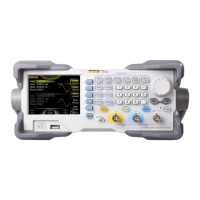Chapter 2 Performance Verification Test RIGOL
DG1000Z Performance Verification Guide
4. Turn on and set the spectrum analyzer:
a) Set the reference level to 10dBm and input attenuation to 20dB.
b) Set the start frequency to 5MHz and stop frequency to 30MHz.
c) Set the resolution bandwidth to 3kHz.
5. Use the cursor function to make measurements and record the measurement
values of the base waveform and 2
nd
order harmonic. Calculate
[1]
the harmonic
distortion and judge whether it is less than -65dBc.
6. Keep the output impedance of CH1 of DG1000Z at 50Ω. Set the output
waveform of CH1 as a sine waveform with 30MHz frequency, 0dBm amplitude
and 0V
DC
offset.
7. Keep the reference level, input attenuation and resolution bandwidth of the
spectrum analyzer as 10dBm, 20dB and 3kHz respectively. Set its start
frequency to 20MHz and stop frequency to 70MHz.
8. Use the cursor function to make measurements and record the measurement
values of the base waveform and 2
nd
order harmonic. Calculate
[1]
the harmonic
distortion and judge whether it is less than -55dBc.
9. Keep the output impedance of CH1 of DG1000Z at 50Ω. Set the output
waveform of CH1 as a sine waveform with 60MHz frequency, 0dBm amplitude
and 0V
DC
offset.
10. Keep the input attenuation, reference level and resolution bandwidth of the
spectrum analyzer as 20dB, 10dBm and 3kHz respectively. Set its start
frequency to 50MHz and stop frequency to 150MHz.
11. Use the cursor function to make measurements and record the measurement
values of the base waveform and 2
nd
order harmonic. Calculate
[1]
the harmonic
distortion and judge whether it is less than -50dBc.
12. Repeat steps 1 to 11 to test the harmonic distortion of CH2 and record the test
results.
Note
[1]
: 2
nd
order harmonic distortion = 2
nd
order harmonic measurement value – base waveform

